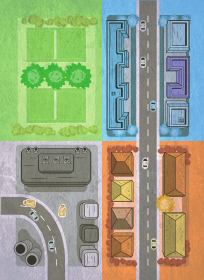Sprawlopolis - Board Game Bites
For the last couple of months, I’ve been into board games. I mean, I’ve been into board games for almost a decade at this point, but for the time being it’s taken over my main hobby spot, much to my wife’s (occasional) chagrin. I’ve also been in something of a writing mood, so I figured I’d write about a few of the games I’ve been playing recently. Once upon a time, presumably in a very similar mood, I posted a few reviews at unrulyreviews, but right now I’m not sure I still like that format, so here’s a small review of a very small game instead.
Sprawlopolis
Sprawlopolis is an example of a surprisingly popular category of games which are entirely composed of eighteen cards. On each card, one side shows part of the city you’ll be building. It’s made up of coloured quadrants, each of which represents a type of city zone, with a couple of road segments passing through some of the quadrants.
On the opposite side is a scoring criteria, three of which are used in each game. These encourage you to build your city in all kinds of unique, sometimes contradictory, ways - in one game you may be aiming to build long, looping roads, parks without pollution, and alternating commercial and residential blocks; in the next, a gigantic industrial sector with roads connecting all the parks might be the way to go. Each of the scoring conditions has a target score - add up the three, and that’s how many points you’ll need to score to win.

The whole game is then placing the fifteen remaining city cards, one at a time, from a hand of three cards, trying to reach the score goal. On top of the scoring criteria from the cards, you’re looking to make large areas of matching zones whilst minimizing the number of separate roads that exist in your city. Cards can be placed either adjacent to or overlapping another card, which allows for a lot of flexibility.
That flexibility is what makes sprawlopolis an interesting spacial puzzle. Figuring out the correct sequence of placements so that this quadrant lines up with that one, whilst those roads are joined up and the industrial zones get covered by something else is very satisfying. On top of that, you get the gentle enjoyment of building something in a system that’s simultaneously a sandbox, and quite tightly restricted, but never with very high stakes. In some ways, I’d say this evokes similar feelings to classic city building games.
On top of this, the setup is an absolute joy. It may seem minor, but coming off the back of a few more fiddly games the ability to shuffle eighteen cards, flip three for scoring criteria, draw three, and start playing immediately is extremely freeing. This very speedy setup, along with the calm but engaging flow of play, makes it very easy to squeeze in a couple of rounds at lunchtime, or before bed.
The game is designed to for multiple people to be able to play cooperatively, and I imagine it’d be a fairly nice, relaxed activity, but I’ve only played it solo and expect it to probably remain that way. It very much has the feeling of a satisfying puzzle, rather than something which would benefit from a layer of interaction. Go in with that in mind, and you just might have a lovely time.